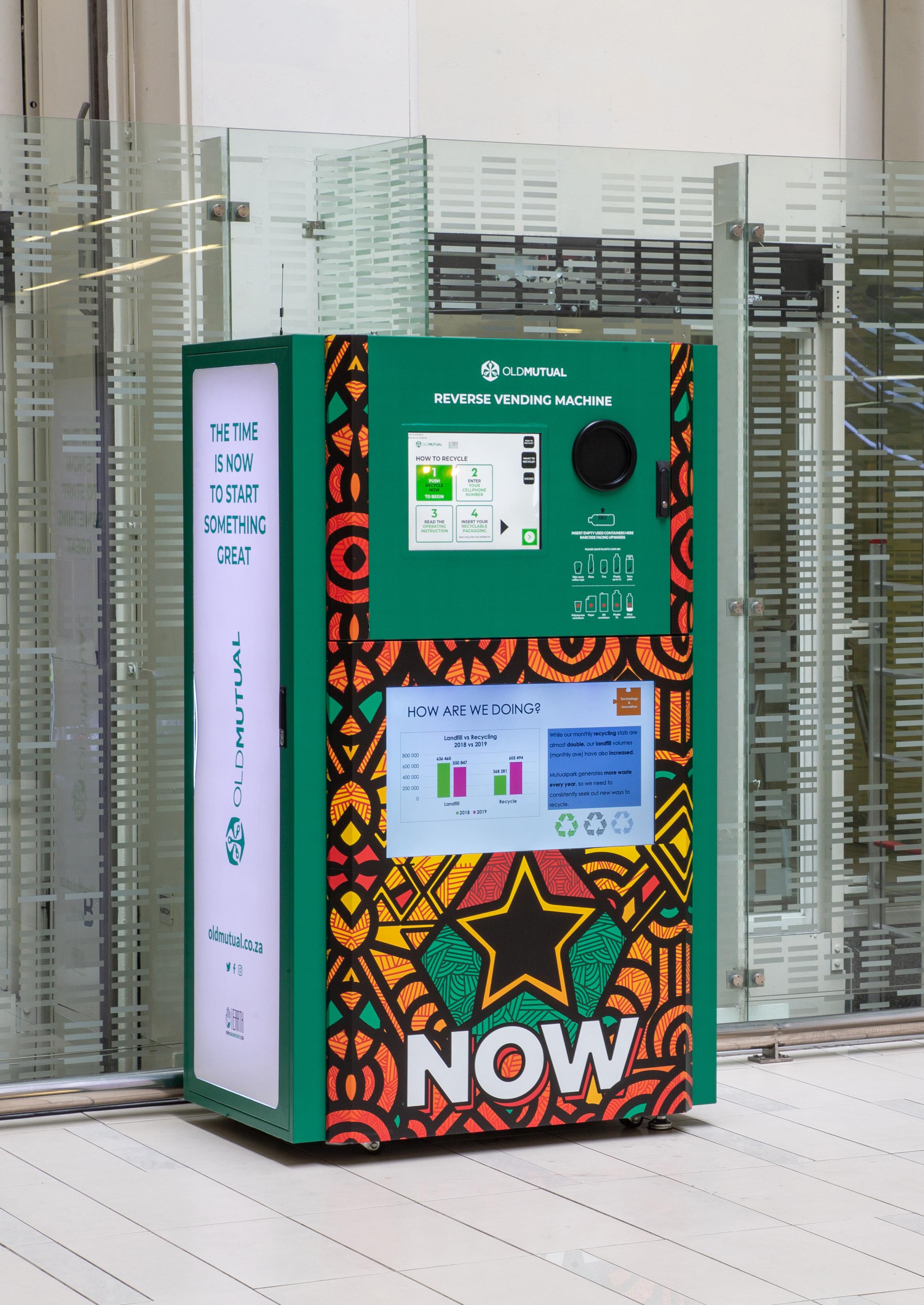











 Old Mutual’s HQ in Cape Town, South Africa
Old Mutual’s HQ in Cape Town, South Africa


has undertaken a transformation by migrating its entire IT infrastructure to the cloud, paving the way for leveraging
ld Mutual Limited is a premium African financial services group that offers a broad spectrum of financial solutions to retail and corporate customers across key markets in 14 countries.
With 179 years of heritage across subSaharan Africa, Old Mutual continues to play a crucial part in the communities it serves as well as in broader society. Old Mutual commenced its digital transformation in 2017 with the aim of using technology to leapfrog its journey to enable its business strategy. The organisation aimed to modernise its operations by using cutting-edge technology but faced obstacles due to its outdated infrastructure and architecture.
As a result, the organisation went on a journey to modernise its infrastructure resulting in a decrease of its on-premises data centres footprint. The modernisation journey led to the migration of its technology infrastructure with a focus on life insurance, and wealth management systems – to Amazon Web Services. This, says Old Mutual’s Group CIO May Govender, has proven to be the leapfrog to its transformation journey. Joining the business in 2021 as Deputy CIO and then shortly thereafter stepping into the acting Group CIO role in 2022 before formally being appointed in 2023, stated that this step has laid the foundation for its digital transformation and has opened avenues for the organisation to pursue cutting edge solutions to meet its business challenges.
“Old Mutual is a 179-year-old organisation, so – as you can imagine – comes with a lot of complexity and challenges. However, the most exciting development for me in the last three years has been Old Mutual’s digital and people transformation journey.”
For an insurance organisation – not traditionally known for rapid change and execution – this transformation has been remarkably swift. “For us to leapfrog and achieve our ambition, we realised we had to take a two-pronged approach. We needed to fix the current issues we were experiencing and get the foundational elements right. At the same time, we needed to figure out what our tomorrow looks like today. The cloud migration was a step towards building for a tomorrow that aligns with our strategy and ambition.”
As Govender describes, Old Mutual did not have the benefit of time when it came to implementing its transformation. The imperative was clear: to get the organisation moving at the pace required for the new digital era. “We did not have the luxury of waiting four to five years, we knew that we needed to make a difference now.”
The two-pronged approach kicked into gear – one track focusing on ripping out legacy infrastructure, the other focused on evolving the customer experience. “We had to work simultaneously to phase out our legacy infrastructure very quickly, while also recognising the importance of transforming our customer proposition and experience.
“Presently, customers encounter a diverse range of experiences across various industries, from companies like Google and Netflix to convenient banking services on
“As an insurance organisation, it’s imperative for us to stay abreast of these customer trends and meet their evolving expectations”MAY GOVENDER CHIEF INFORMATION OFFICER, OLD MUTUAL
the go. These encounters significantly shape customers’ expectations regarding what constitutes a positive experience. As an insurance organisation, it’s imperative for us to stay abreast of these customer trends and meet their evolving expectations.”
“Our biggest challenge in achieving this ambition was the ability to execute at pace as we didn’t have the luxury of time to have the foundational elements and technologies in place; so really it’s about how we fix the aeroplane while it’s in flight.”
This cloud transformation journey began around 2019 when Old Mutual decided to migrate its IT estate to the cloud at the back of the digital transformation that commenced in 2017. “At that time, the organisation was facing challenges associated with ageing data centre infrastructure, suffering from several stability issues and downtime that impacted business operations.”



Creating enterprise-wide golden data records is hard work. and maintenance of golden records that drive business outcomes, achieving what MDM can’t – three times faster and at one-third of the cost.
Discover the future of data management. Book a demo why leading companies are abandoning their rules-based MDM solutions in favour of Tamr ’s advanced AI technology for data mastering.
www.tamr.com




For years, companies have relied on rules-based master data management (MDM) to solve their data mastering needs.
For years, have relied on rules-based master data management (MDM) to solve their data mastering needs.
Old Mutual adopted Tamr ’ s patented data and saw immediate results:
But when data the rules in MDM solutions become ineffective, making it impossible to achieve the goal of creating golden records.
But when data changes, the rules in MDM impossible to achieve the goal of creating golden records.
To overcome this businesses are embracing a new, AI-first approach to technology that will break down data silos once and for all.
Old Mutual, a 179-year old African financial services group that supports retail and corporate customers across 14 countries, the their data was evolving and was trapped in three siloed MDM solutions. Without a holistic, 360-degree view of their customers, Old Mutual was unable to scale the accuracy and quality of their services to meet modern customer demands.
To overcome this challenge, businesses technolog y that will break down data silos once and for all. ser vices group that supports retail and corporate customers across 14 countries, recognized the challenge: their data was evolving and was trapped in three siloed MDM solutions. Without a holistic, 360-degree view of their customers, Old Mutual was unable to scale the accuracy and quality of their ser vices to meet modern customer demands.
Further, Old Mutual’s existing MDM solutions couldn’t interoperate with their cloud-based approach, increasing the pressure to accelerate the modernisation of their existing MDM solutions.
Further, Old Mutual’s existing MDM solutions couldn’t with their approach, pressure to accelerate the modernisation of their existing MDM solutions.
Old Mutual Tamr’s AI-first approach to mastering customer data and saw immediate results: data accuracy six weeks, resulting in golden records
• Improved data accuracy by 69% in just six weeks, resulting in golden records
• Decommissioned legacy MDM solutions within nine months, saving millions of dollars in costs
• Decommissioned legacy within nine months, saving millions costs
• data integration complexities and eliminating data silos
Simplified their IT landscape, reducing data and silos
And they accomplished all of this on-time, on-budget, and without hiring new resources.
And they accomplished all of this on-time, on-budget , and without hiring new resources.
Today, Old Mutual is a stronger and more agile organisation. With a holistic and accurate view of each customer, the that enhance customer satisfaction and loyalty.
Old Mutual is a and more agile organisation. With a holistic and accurate view of each customer, the firm can now offer more personalised, efficient, and responsive services that enhance customer satisfaction and loyalty.
Overcoming like the ones
Overcoming challenges like the ones Old Mutual faced requires an AI-powered, that accelerates the discover y, enrichment , and maintenance of trustworthy customer golden records that drive business growth and power experiences customers expect . Ready to get started?
Old Mutual faced requires an AIpowered, human-refined approach. This strategy accelerates the discovery, enrichment, and maintenance of trustworthy customer golden records to drive business growth and power the experiences customers expect. Ready to get started?


“We had to work simultaneously to phase out our legacy infrastructure very quickly, while also recognising the importance of transforming our customer proposition and experience”
MAY GOVENDER CHIEF INFORMATION OFFICER, OLD MUTUAL
With this in mind, Old Mutual had two options: invest heavily in a major data centre and infrastructure upgrade or advance the modernisation to the cloud to address its legacy infrastructure challenges and create a resilient platform, allowing it to focus on business value activities rather than ongoing infrastructure problems.
With organisational support and investment – key enablers for the success of the transformation – Old Mutual embarked on the cloud migration. “We had a migration path with the completion aimed for the end of 2021, the implementation approach was divided into three waves, with a very carefully thought through breakdown on business impact, each application was given a target wave based on this analysis. After each wave, a detailed retrospective was done to analyse
Old Mutual shifts IT infrastructure to cloud, embracing data and AI innovation


what worked and what didn’t. If there was a need to pivot on our approach, we did so with the assistance of AWS Professional Services.
“A few months later than anticipated, in March 2022, we had completed our migration journey of our South African estate to the cloud. Our African countries are still in progress, with countries ranging between 60% and 90% complete due to regulations and complexities in each country. Our short-term insurance business has also commenced on its migration journey with the advantage of using the SA life business blueprint in its learnings.”
Old Mutual’s primary goal was to decommission its data centre as soon as possible, which has largely been accomplished. As Govender describes, a lift-and-shift strategy made the most
sense at that point. “We have a small remaining footprint of applications that didn’t warrant a lift-and-shift for business value reasons, and we’re now looking at modernising our applications, leveraging cloud-native capabilities, and optimising our total cost of ownership (TCO) while driving business value with AWS.”
From a resilience perspective, the organisation has seen a 50% year-over-year reduction in business impact hours. Developers no longer spend time supporting infrastructure and can quickly spin up environments, allowing them to focus on solving business problems.
“With a huge percentage of our state now in the cloud, we can leverage data as a key enabler for Old Mutual’s digital transformation.”
WATCH NOWFor Old Mutual, the recent move to the cloud has been transformational in reducing operational overhead and technical debt. Prior to the cloud migration, system downtime directly impacted business operations, sales and client service. “But now that we are in the cloud, we provide a much more stable service that allows us to respond faster to business problems,” states Govender. “With this, the conversation has shifted from addressing operational problems to creating business value – a huge change.”
Productivity has seen a dramatic boost as well. Solution delivery cycles that previously involved lengthy hardware shipping and implementation can now be rapidly deployed in the cloud environment. “The speed in which we deliver our solutions has dramatically changed. We no longer have lengthy timelines in which we provision hardware delivery and implementation cycles.”
Performance has also substantially improved, with batch processes that previously took 18-24 hours now completed in a fraction of the time. “As an insurance organisation we manage a vast amount of data making batch processing a significant challenge for us. Previously, our batchprocessing tasks would disrupt business operations and take an excessively long time, typically lasting 18 to 24 hours. However, after adopting a new approach, the duration of these tasks has been reduced to six to eight hours with work being done to further reduce this.”
The reduction in processing time is just the start of the operational efficiencies Old Mutual has been able to achieve.




“Tamr has been instrumental in helping Old Mutual build the foundational elements for our data strategy, a critical requirement for achieving our long-term ambition of becoming an AI-led insurance organisation”MAY GOVENDER CHIEF INFORMATION OFFICER, OLD MUTUAL
“As we continue to leverage cloud solutions, we are finding more opportunities to streamline our operations. For instance, we can now utilise native cloud solutions to reduce the complexity of our application landscape.
“Previously, we had a vast on-premises database infrastructure. By migrating to the cloud, we have commenced with consolidating our databases thereby simplifying our overall architecture. This cloud migration has opened avenues for simplification, enabling us to address technical debt more effectively.”
Cloud security is of utmost importance in Old Mutual’s cloud adoption strategy. The organisation follows a shared responsibility model, where the cloud provider secures the underlying infrastructure, and Old Mutual is responsible for securing its data and applications.


“By leveraging native cloud services, we can assess resource compliance against our internal standards and automatically remediate non-compliant resources in real time. This is a vast improvement over our previous approach, which involved a lengthy process of assessment and vulnerability remediation. We have also implemented advanced security measures by utilising the cloud provider’s security features, especially for protecting our sensitive data.”
As a financial institution, Old Mutual is subject to stringent regulations and industry standards from authorities.
To ensure compliance, the organisation has dedicated security teams that work closely with cloud provider AWS. “Since migrating to the cloud, we have observed substantial improvements in our security landscape.
“Our primary focus now is on operational aspects of cloud security, such as our Security Operations Centre (SOC) and access management. While these may not be the most high-profile initiatives, they are crucial for achieving operational efficiencies in our security posture, and we are actively working on enhancing these areas.”


As Govender highlights, one of the most significant lessons her team has learned from the cloud transformation was the importance of starting its FinOps (Cloud Financial Management) capability early on.
“Whilst in the cloud, we are required to manage consumption models, resource allocation and costs proactively to avoid overspending.” She admits that, initially, Old Mutual’s focus was solely on the forward-looking migration, with limited oversight on the cloud capabilities that were implemented in the subsequent migration
waves and this led to a continuous increase in costs.”
“For us, the key learnings were to firstly initiate the FinOps journey as early as possible to gain control over cloud spend, and secondly, instead of solely relying on lift-and-shift migration, we could have taken the opportunity to modernise specific applications concurrently, rather than having to undertake a separate modernisation journey later.”
On the positive side, the rapid migration had its benefits. “It forced our engineers to start working in the cloud environment quickly, prompting them to learn and upskill themselves on cloud-native technologies and modernisation practices, reducing our reliance on third-party vendors,” she says.
“Upon reflection of the overal journey, we could have expedited the modernisation process rather than treating it as a separate, subsequent phase. Additionally, we could have put more effort into upskilling developers on cloud financial management and cloud-native capabilities, empowering them to make well-informed decisions from the outset.
Govender also highlights the value of having an AWS product owner closely involved throughout the journey, providing guidance, and enabling Old Mutual to make informed decisions along the way. “While there are areas where we could have improved, successfully migrating over 2,000 servers and 800 applications within a three-year timeframe was a significant achievement, and we take pride in our cloud transformation journey.”


“The key focus should be on leveraging AI to drive tangible business value”MAY GOVENDER CHIEF INFORMATION OFFICER, OLD MUTUAL
Partnership with Tamr helping drive transformation success To support its digital transformation initiatives, Old Mutual has collaborated with several partners across various domains such as cloud, data and customer/ advisor experience. “We look to our partners to bring best practices and assist with execution. However, a crucial aspect for us is to establish contracts that focus on delivering tangible business value for both parties, ensuring a mutually beneficial value-sharing arrangement.”
Among Old Mutual’s many partnerships, including those with cloud providers like AWS, the collaboration with Tamr has been particularly significant from a data perspective. “As an insurance company rather than a technology firm, we recognise that we cannot excel in all areas. Therefore, we seek out organisations that possess specialised expertise and best practices to augment our capabilities.”
Initially, Old Mutual partnered with Tamr to replace its legacy master data management system and to leverage machine learning for modernising its data capabilities.
This, Govender explains, was a task that simply could not have been accomplished internally.
“Tamr has been instrumental in helping Old Mutual build the foundational elements for our data strategy, a critical requirement for achieving our long-term ambition of becoming an AI-led insurance organisation.
“Over the past two years, our partnership with Tamr has facilitated our journey, and we have mutually supported each other in driving execution success. Moving forward, we will continue to deepen our collaboration with Tamr, leveraging their expertise to enable our business and drive tangible value, as data is a key enabler in our strategy.”
In South Africa, Old Mutual has embarked on a major initiative to boost its digital solutions across our life insurance business and value chain. Digital transformation is a key component of the organisation’s customer-centric strategy, and Old Mutual has been on a multi-year journey to integrate and implement relevant technologies across its operations.
“For the next 12 to 18 months, we will continue our digital transformation journey, with a strong emphasis on driving improvements in customer and advisor journeys through digital enablement,” Govender highlights. “We also aim to accelerate our AI ambition by leveraging our investments in cloud and data capabilities, fostered through our partnerships with Tamr and AWS, to enable our data strategy.”




As she describes, AI is currently a major trend that is set to continue. “We will continue to improve our AI capabilities. The key focus should be on leveraging AI to drive tangible business value. Many organisations are experimenting with AI, but few have truly cracked how to harness it effectively to propel their businesses forward. Identifying use cases that can deliver substantial value will be critical in the coming years.
“AI has the potential to automate mundane tasks, which is especially valuable for an insurance company like ours that deals with immense complexity and vast amounts of data. Enabling zero ops through AI can allow our staff to concentrate on enhancing customer experience and driving innovation.”
Ultimately, Old Mutual’s two-pronged approach to its transformation involves simplifying its technology landscape while simultaneously building engineering capabilities. “We are transforming our workforce by developing mastery in specific skill sets such as data science, engineering and AI. We will also deliver on our key transformational programmes initiated two years ago, to provide integrated experiences when interacting with customers and advisors across our multiple product suites.
“The next 12 to 18 months are critical for us to realise the value of these initiatives and achieve our transformational objectives. Our focus will be on enabling an integrated experience, rather than the current fragmented customer experience.”
